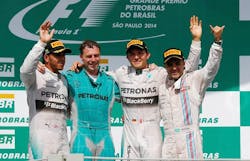Brazilian Grand Prix: Pirelli Report
Mercedes driver Nico Rosberg has closed the gap in the drivers’ championship to his team mate Lewis Hamilton after winning the Brazilian Grand Prix from pole, using a three-stop strategy. Rosberg did an opening stint on the soft tire and then completed the race with the medium tire, in high temperatures that were in contrast to the expected rain.
Hamilton adopted a similar strategy to finish runner-up, 1.5 seconds behind his team mate, after losing some time when he ran wide earlier in the race. After both made their final pit stops, Hamilton was able to use tires that were one lap fresher to challenge Rosberg for the lead, setting up an exciting finale. In the end, Rosberg sealed his eighth career victory and his fifth win of 2014.
Most drivers started on the soft tire, which was up to a second per lap faster around Interlagos than the medium compound. Force India’s Nico Hulkenberg adopted an alternative three-stop strategy, using the medium tire from the start until his final stint on the soft. The extra speed at the end of the race helped him to finish eighth, making up four places from his grid position. Daniil Kvyat (Toro Rosso) used a similar strategy to finish just outside the points from the penultimate place on the grid.
As expected in the high track temperatures of more than 50 degrees – the highest seen at the Brazilian Grand Prix in recent years – the theoretically fastest three-stop strategy was used by nearly all the drivers. The highest-placed driver to stop only twice was Ferrari’s Kimi Raikkonen, who finished seventh after a thrilling battle that was just as intense as that which took place at the very front of the field. The drivers’ championship will now be decided at the final race of the season in Abu Dhabi, with double points on offer.
Pirelli’s motorsport director Paul Hembery said: “We saw a mesmerizing battle between the two Mercedes drivers, during which they had to balance their desire to beat each other with the need to get the most out of the tires in these very high temperatures. Ambient and track temperatures were certainly higher than everybody anticipated, which caused some degree of blistering and graining, particularly at the start of the race with heavy fuel, soft tires and the hottest temperatures of the day. This did not however affect tire performance. The new surface created a number of challenges for everyone all weekend, including the teams, the drivers and ourselves. Most drivers went for a three-stop strategy, which we predicted to be the fastest around Interlagos. However, Kimi Raikkonen made a two-stop strategy work as well, at one of the most demanding races of the year. ”
